Simple Machines (Part-3): Wheel-Axle, Screw & Gears Explained
With a round wheel fastened to the axle, the axle and wheel constitute a particular kind of simple machine. Combining these two gives you a mechanical advantage when lifting loads when the force needed is less than the weight of the thing.
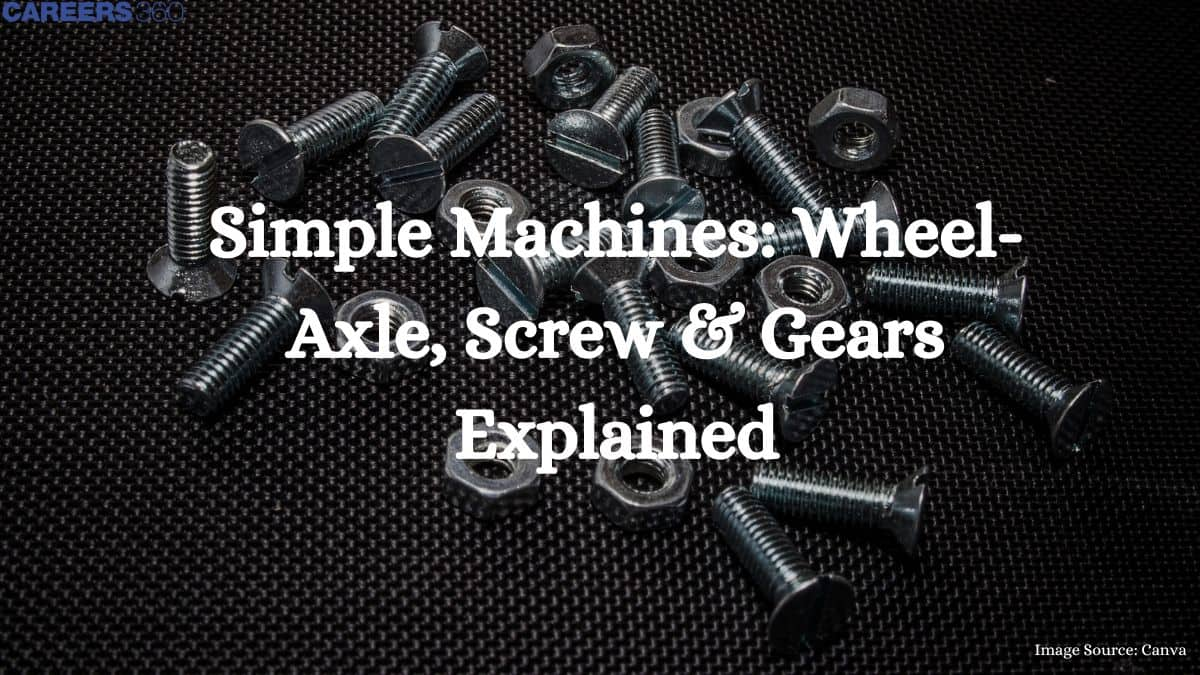
When force is supplied to the wheel, the attached axle rotates, producing the torque, also known as the rotational force. Given the disparity in wheel and axle sizes, it can be assumed that the two separate components are moving in a distinct length of time. This is because, as the picture below illustrates, the wheel and axle's different circumferences provide a mechanical advantage.
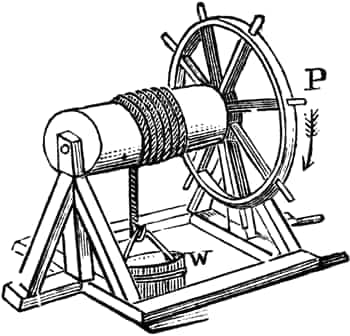
Mechanical Advantage (MA) = [ Radius of Wheel / Radius of Axle ]
*This implies that, compared to a smaller wheel, a larger wheel will take less force to move the same load.
6b. Application
The wheel and axle mechanism are utilised in everyday life, as discussed in the example below :
Automobiles: Wheels on bicycles, cars, and other vehicles reduce the drag and enable the rolling motion for higher loads.
Doorknobs: The spindle (axle) in the door knob takes the mechanical advantage of the difference in circumference of the knob and the spindle to facilitate the locking and unlocking in a more accessible manner.
Wrenches: Utilises the Wheel and Axle mechanism to tighten or loosen a bolt or nut, converting the handle into a type of wheel.
Windlasses: As shown above in the example, a device utilises the system to draw/pull the water out of the well.
6c. Advantages
Significant mechanical advantage caters for the easy lifting of heavy objects.
Versatility: Adaptable to several applications and the foundation of modern machines.
Friction Reduction: By reducing the amount of friction between surfaces, wheels facilitate easy movement
7. SCREW
7a. Introduction
The screw is an example of a Simple machine that converts rotational force into linear movement. It consists of a helical thread, unlike an inclined plane revolving around a cylindrical axis. The force is applied using screws in a controlled way to lift loads as well as to hold objects together. The diameter of the shaft and the distance between threads, also called pitch, are used to determine a screw’s mechanical advantage.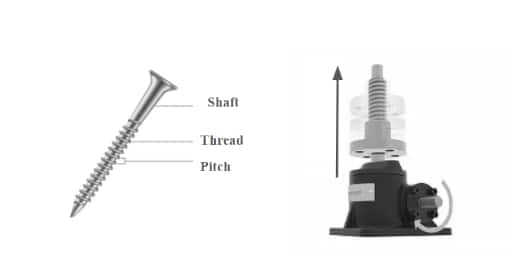
A screw advances or retreats when it is turned because the inclined plane (threads) changes the rotational force to a linearly applied force. A screw's mechanical advantage can be computed as follows.
Mechanical Advantage = Circumference of Shaft of Screw/ Pitch of the Screw
7b. Application
The screw has multiple applications as discussed below :
Fastening: In construction and fixing of furniture, for instance, screws are often used to hold materials together.
Lifting: Screw jacks can be used to lift or lower heavy loads through the turning of the screw.
Machines: Screws are used in machines to control motion, exert force, and alter a part's shape.
Screw-style bottle caps twist to expose threaded surfaces, which securely shut containers.
7c. Advantages
Mechanical Advantage: The ability to apply force and lift weights makes screws favorable in terms of mechanical advantage.
Precision: The ability to apply force and regulate movement is made possible by screws.
Screws are incredibly versatile tools that work well with a wide range of materials.
Screws are widely available and can be applied to almost any material or situation.
8. GEARS
8a. Introduction
Gears are one of the most significant factors for torque transfer and Speed Exchange. This is because when the driver gear is turned, the teeth of the driver gear push against the teeth of the driven gear and thus cause the driven gear to turn in the opposite direction. The system’s speed and mechanical advantage are defined by the number of teeth on the gears and the number of gears in the system.
Gear Ratio can be computed as follows :
Gear Ratio = [ Teeth in Driven Gear/ Teeth in Driving Gear]
Gear Ratio = 25/75
= 1:3 (proportionately, the speed varies)
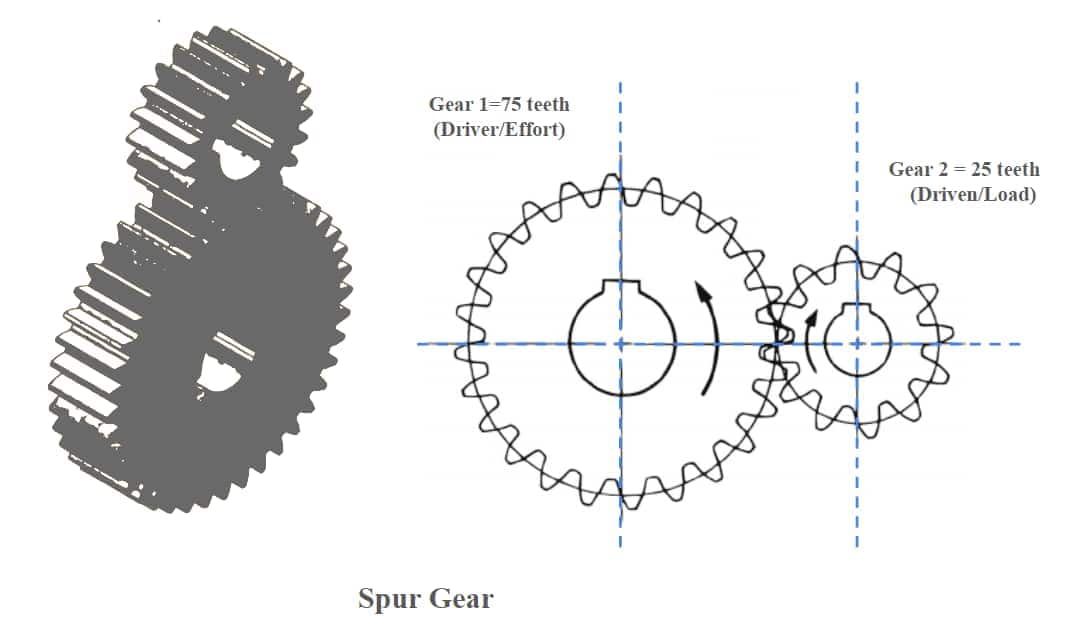
You can also refer to:
- Simple Machines (Part-1): Inclined Plane & Lever
- Simple Machines (Part-2): Wedges, Pulleys, Springs
- Visualisation Analogy
- Fundamentals of Geometry for 3D Shapes
- Projection and Views
Important to know: Gears Type
Planetary Gears
A planetary gear system consists of a sun gear, planet gears that orbit around the sun gear, and a surrounding ring gear. This system has a compactes value and optimizes torque transfer. Additionally, it is useful for situations that require high torque and several gear ratios. Due to their efficiency in load-to-space ratio, planetary gears are frequently found in suspension systems, heavy-duty automobiles, modular robotic systems, and electric vehicles.
Rack and Pinion Gears
The rack and pinion set serves the purpose of translating rotary motion into straight line movement. While the pinion transforms circular motion into linear motion, the rack gear turns motion into translation. This set is ideal wherever straight movement is required, serveing as a core component for steering systems in automobiles, tools, and elevators. Its effectiveness stems from the straightforward design which provides accurate movement along a line.
Differential Gears
Differential gears enable two spinning parts to rotate at varying rates, a required operation when making turns in cars. The differential separates the power from the engine and distributes it to the wheels through gears, permitting the inside wheel to rotate at a slower rate than the outside wheel. This avoids tire wear and smooths the turn. Differential gears play an important role in cars, off-road vehicles, and heavy equipment, where they facilitate improved control and maneuverability.
Bevel Gears
Bevel gears are used to transmit motion between shafts that are set at right angles to each other. The teeth of bevel gears are angled to allow for the smooth transfer of motion. These gears are commonly found in automotive drivetrains, marine systems, and industrial machinery, where a change in direction is needed. Bevel gears specialize in withstanding high torque and are frequently employed when there is little space but torque has to be transmitted at 90 degrees.
Worm Gears
Worm gears are a gear system in which a worm with a screw-like appearance mates with a gear referred to as the worm wheel. This type of system is well-known for delivering extremely high torque output in a small package and is commonly found in applications that need extreme reductions in speed. Worm gears are very commonly employed in winches, lifts, and conveyor systems, where high mechanical advantage and accurate control are required. They also benefit from being self-locking, as they lock the system when not actively being driven, preventing backdriving.
# Trick to find Direction of Gear Rotation
Even combinations of gears always rotate in the opposite direction. For Example, if the driver gear is rotating in an anticlockwise direction in a combination of gears, the last driven gear would be rotating clockwise(opposite direction).
Odd combinations of gears always rotate in the same direction. For Example, if the driver gear is rotating in a clockwise direction in an odd combination of gears, the last driven gear would also be rotating in the clockwise(opposite direction).
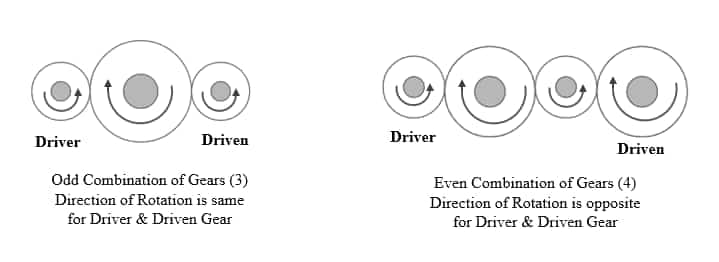
8b. Application
Since gears transfer force and motion, they are used in many processes. Below are some function of gears:
Automobiles: The wheels are driven by the engine’s speed and torque, which are controlled by gears in the transmission system.
Watches and clocks: The hand movement is regulated through gears to measure the time well.
Machinery: Industrial gears are used in the machinery to provide and control the movement of various parts.
Bicycles: Bicycle gear systems enable riders to change the effort required to pedal depending on the terrain.
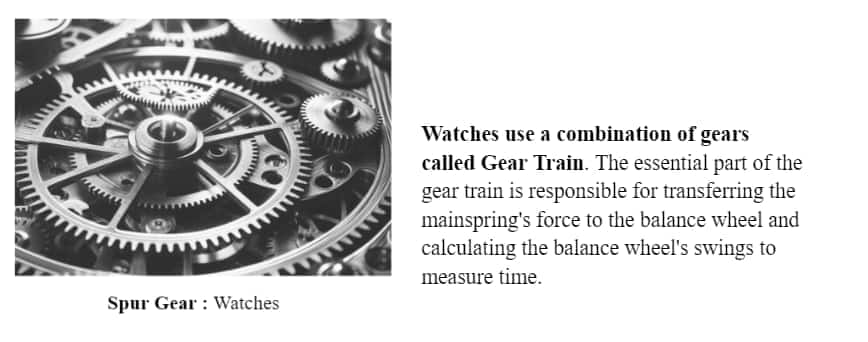
8c. Advantages
Efficiency: Extremely effective at transferring force and motion.
Precision: Precise management of torque and speed.
Versatility: Employed in a range of settings and applications.